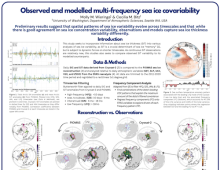Observed, reconstructed, and modeled sea ice covariability across low- and high-frequency timescales
Molly
Wieringa
University of Washington
Poster
Due to the myriad environmental, socioeconomic, and physical roles occupied by Arctic sea ice, there has been sustained interest in sea ice predictability and change over the last three decades. The existing literature examines the contributions of various forced and naturally occurring modes to variability in metrics like sea ice concentration, sea ice area, and sea ice extent. This singular focal point of past research is largely due to a lack of sea ice thickness and volume observations, which have only recently become consistently available across the Arctic. However, sea ice thickness is a crucial determinant of sea ice “memory” and the reemergence of sea surface temperature signals in seasonal and inter-annual sea ice changes. Additionally, while past studies have largely focused on inter-annual or decadal variability, there is increasing interest in sea ice variability at higher frequencies. In this work, we examine sea ice variability in observations of concentration and thickness using a joint frequency component analysis (FCA) method designed to target variability on inter-annual and seasonal-to-subseasonal timescales. Using the FCA, we quantify the contributions of the forced response and naturally occurring modes to variability on each timescale and compare the results to similar analyses of a sea ice reconstruction and six of the CLIVAR large ensembles. Our initial results indicate an important contribution from a Pacific-Arctic teleconnection in observations on both inter-annual and seasonal-to-subseasonal timescales. Multiple approaches for isolating the forced response are implemented and discussed.

wieringa-molly-polar-poster.pdf
(3.27 MB)
